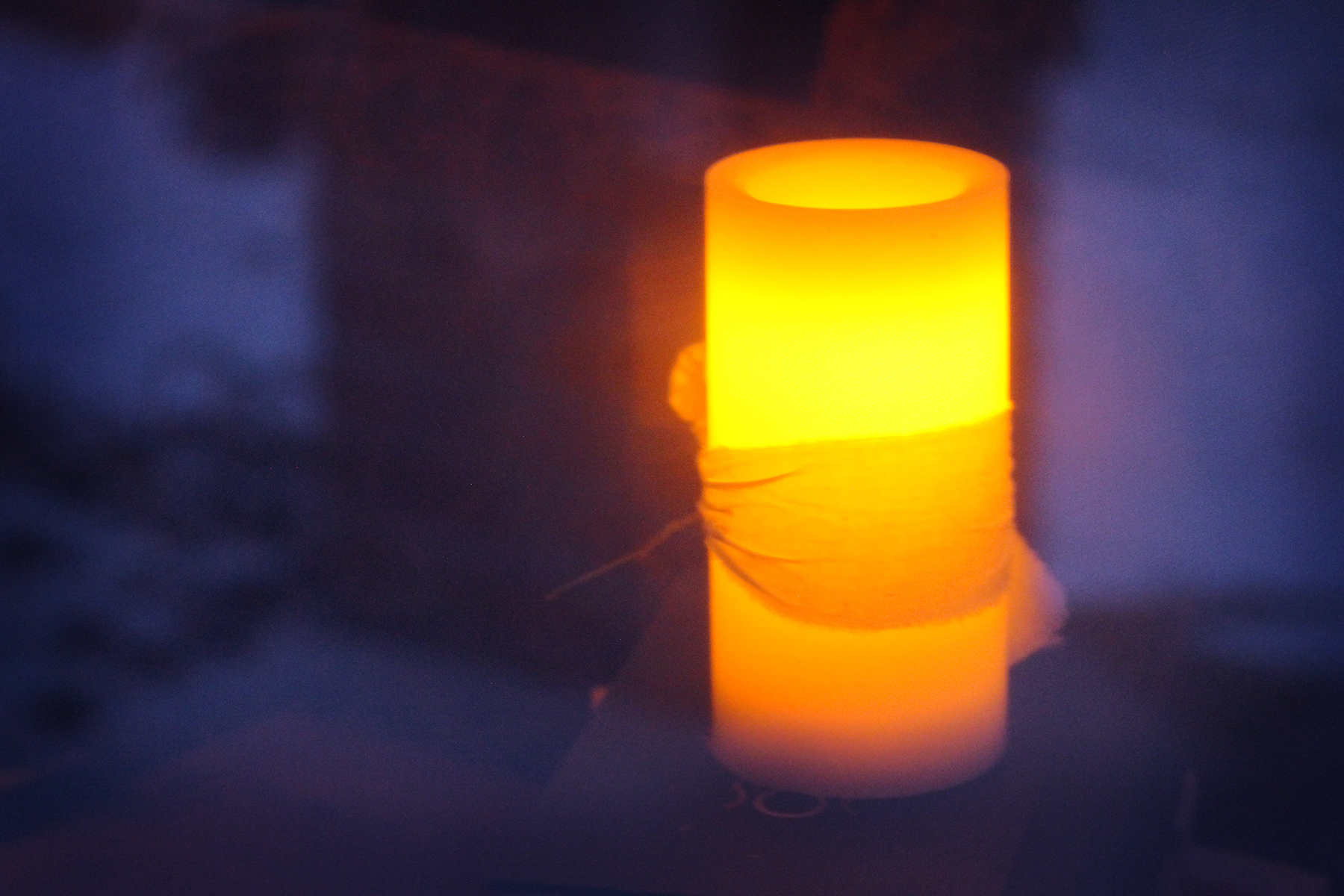I still have Christmas candles in my windows. Not real ones, of course, or even the plug-in kind that take a nightlight bulb, but those little battery-powered LED lamps that mimic the flicker of open flame. My experimental purchase of ten for the front of the house back in late November pleased me so much that I immediately ordered more—enough for almost every window, even the small dormer in the attic.
It was undeniably heartwarming, of an early winter twilight, to pull into the driveway and see the house slowly materialize under a violet sky with those friendly lights winking and glancing from the windows. Equally so, coming up from the barn after evening chores, when every aperture shone an invitation to rest from the day’s labors and just savor the beauty of the season we were in.
There was a Christmas tree, of course, brave against December’s gloom, and the rooms were fragrant with cedar and fir, citrus and spice. Scarlet ribbons adorned the bannister, the chandeliers, the candlesticks—even the dogs!—and candle-powered angel chimes twirled on the kitchen mantle. After a year of displacement due to a catastrophic house fire, it was our first Christmas back in our home, and the goodness of it all made Advent swell with bright promise, filling those blessed Twelve Days with a mirth unequaled, even in all our happy Christmases past.
Hence it was no surprise, in the early days of the New Year, to feel a bit let down. Like my friend Anne Shirley, I’d been soaring for weeks on the wings of anticipation, living from one gratefully regathered tradition to the next, feasting on the joy of a house crammed with friends and family. We’d hosted our book club dinner, Christmas Eve, Christmas Day, and Twelfth Night, not to mention house guests, an impromptu caroling party, and my annual little post-Christmas recap tea with two of my best friends. After six straight weeks—seven, if you count Thanksgiving—of baking, cleaning, decorating, table-setting, bed-making, meal-planning, entertaining, and merrymaking, a thud was inevitable.
However, as January wore on, it became clear that this flattening of spirits was no mere thud—it was a Thud of the most serious kind. The kind Anne herself would describe, with characteristic flourish, as the “depths of despair”:
“I’m in the depths of despair. Can you eat when you are in the depths of despair?”
“I’ve never been in the depths of despair, so I can’t say,” responded Marilla.
“Weren’t you? Well, did you ever try to imagine you were in the depths of despair?”
“No, I didn’t.”
~ Anne of Green Gables, L.M. Montgomery
While I’m always one to prefer a book over a movie, I have to admit that Colleen Dewhurst’s Marilla in the 1985 film version sometimes feels a little more fully-fleshed to me—especially in this scene, when, lamp in hand, she turns on the stairs to look back at Anne with one of her grim, honest expressions and adds, “To despair is to turn your back on God.”
When I was younger, I thought that scene was humorous. Identifying with Anne’s high-flown imagination and full spectrum of emotions, Marilla always seemed like an endearing stick-in-the-mud, the perfect foil to our heroine’s enchanting personality. But while it’s true that Anne’s whimsy works its way into Marilla’s heart, softening her with unwonted tenderness, a thorough acquaintance with the series will prove Marilla’s maturing influence on Anne, and the ways in which her courage and values distill themselves into the younger woman’s soul, equipping her for the harsh realities of life. It’s no coincidence that Anne names her youngest—and most free-spirited—daughter after Marilla: the second Rilla has more scope for feeling and need for courage than either of her older sisters.
I’ve been contemplating Marilla, and her attitude towards despair in these winter-without-Christmas days, holding my own doldrums up to the lamp of her statement to Anne on the stairway. To be sure, my soul is tired—still healing from the trauma of the house fire and the exhaustion of the rebuild—and while I’m endeavoring to make space for that fact, the fact remains that in these early weeks of the New Year I have struggled to keep despair at bay. Or I’ve failed to shepherd my soul in the direction of hope, which is the real battle.
At any rate, I’m realizing that Marilla was right: our circumstances, and even our emotional needs, may be beyond our control—but despair is always a choice.
The beautiful thing is that hope is a choice, as well, and that, like faith, its substance is rooted in a reality that does not change with the ebb or flow of fine feelings. If, in discouragement or weariness or overwhelm I (inadvertently or otherwise) give God the cold shoulder, God is not going to reciprocate. Never coercive or manipulative, His love will follow us into the darkest places of our lives, and, with staggering courtesy, wait—for the least glance over our shoulder, the faintest acknowledgement of what, in our sunnier times, we doubt that we could ever doubt: namely, that God is present, and that the conditions of our lives are watched, kept, presided over, and held by Love.
In the winter seasons, however, even such a glance can feel like a journey, a formidable effort to reorient our souls towards hope. When the world without is barren and grey, and the world within is weary and sad, the pilgrimage back into light seems daunting—perhaps even impossible. But, over the years, as I’ve learned to recognize the connection between physical fatigue and emotional depletion, a gentle truth has risen to the surface: the cultivation of hope, like the cultivation of faith, is often a process that works from the outside in, moving through acts to experience. In other words, caring for hope in my life can look as ordinary as a succession of tiny choices that gradually build to a spring-like return of joy.
Some of these choices are so quotidian they might seem silly or insignificant, like a really good pot of tea, every single day, or a nice box of chocolates, savored slowly. But caring for hope can also look like running to the door at the least sound of the sand hill cranes, stepping out into the cold to honor—and affirm—their trumpeting confidence in the coming spring. Sometimes it means sitting at my piano for an hour or two on a busy day, allowing emotions to flow out of my fingers and my mind to commune with the memory of God’s faithfulness. Sometimes it’s as simple as re-reading a favorite novel, or as stupendous as pulling out the prayer book once more and keeping the hours.
This year, the tending of hope has meant rows of seed flats under a light in the basement, and ducklings in a brooder in the barn. And while I’m tempted to worry prodigiously about both, both are a living, growing witness to God’s ever-present force of renewal in our lives—and in our world. For all my ‘high-flown imagination and full spectrum of emotion’, mine is an intensely tactile soul; I need constant association with the practical, the commonplace, the mundane. For it is in such ordinary places that the temporal intersects with the eternal, and a heavenly beauty breaks upon this earthly life.
Hope is not wishful thinking, or an aspirational daydream.
It is a confident expectation in the goodness of God, cultivated by such everyday things as the song of a bird, the scent of a coming rain. Or the wink and flicker of a battery-powered candle in the window.
The featured image “Candle in the Window for Lanier” is courtesy of Lancia E. Smith for Cultivating.
Lanier Ivester is a homemaker and writer in the beautiful state of Georgia where she maintains a small farm with her husband, Philip, and an ever-expanding menagerie of cats, dogs, sheep, goats, chickens, and peacocks. She keeps a web journal at www.laniersbooks.com and is also the proprietress of an online bookshop specializing in rare and out-of-print titles from a gentler era.
Leave a Reply
A Field Guide to Cultivating ~ Essentials to Cultivating a Whole Life, Rooted in Christ, and Flourishing in Fellowship
Enjoy our gift to you as our Welcome to Cultivating! Discover the purpose of The Cultivating Project, and how you might find a "What, you too?" experience here with this fellowship of makers!


Add a comment
0 Comments